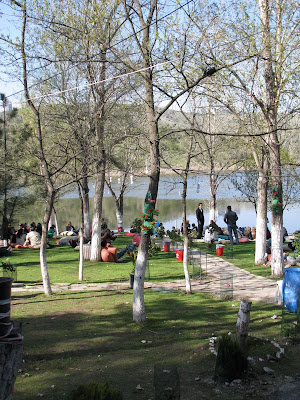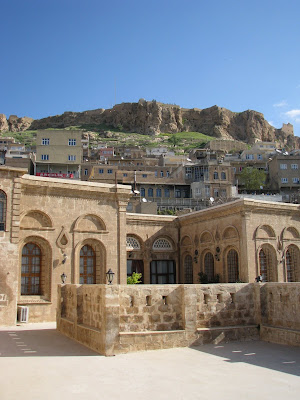
The weekend after spring break, my friend, Wowie, and I boarded the overnight train for Istanbul. My friend, Megan from Montana and her mom were arriving in Istanbul on Saturday for a travel agents' conference, and luckily the International Film Festival and the Tulip Festival were going on.
These are the models for the Ottoman tulip design: the pointy-tipped red ones.



That morning, Wowie and I visited the Dolmabahce Palace (stuffed garden palace): the largest of palaces on the Bosphorus. It was built in the 19th century as an ostentatious show of Ottoman wealth, and is the palace where Ataturk passed away.





That afternoon, we saw two films on Istiklal Caddesi as part of the International Film Festival, and by chance (and similar tastes) ran into Dale (my teaching partner) and Rukiye (Turkish Literature teacher and friend). We saw two films, one from Korea (A Brand New Life) which I LOVED and one from Palestine (The Time That Remains) which was okay.


We heard the director of The Time that Remains field questions after his film, which is always interesting.


That night, we met up with Megan and her mom for dinner, and then the next morning toured Topkapi Palace.




I want a reading room/library like this:



This palace reminds me of William Butler Yeats' "Sailing to Byzantium," especially after I spent time explicating it this past summer at the Poetry course in Italy. The golden birdcage reminded me especially:

Sailing to Byzantium
by William Butler Yeats
THAT is no country for old men. The young
In one another's arms, birds in the trees
- Those dying generations - at their song,
The salmon-falls, the mackerel-crowded seas,
Fish, flesh, or fowl, commend all summer long
Whatever is begotten, born, and dies.
Caught in that sensual music all neglect
Monuments of unageing intellect.
An aged man is but a paltry thing,
A tattered coat upon a stick, unless
Soul clap its hands and sing, and louder sing
For every tatter in its mortal dress,
Nor is there singing school but studying
Monuments of its own magnificence;
And therefore I have sailed the seas and come
To the holy city of Byzantium.
O sages standing in God's holy fire
As in the gold mosaic of a wall,
Come from the holy fire, perne in a gyre,
And be the singing-masters of my soul.
Consume my heart away; sick with desire
And fastened to a dying animal
It knows not what it is; and gather me
Into the artifice of eternity.
Once out of nature I shall never take
My bodily form from any natural thing,
But such a form as Grecian goldsmiths make
Of hammered gold and gold enamelling
To keep a drowsy Emperor awake;
Or set upon a golden bough to sing
To lords and ladies of Byzantium
Of what is past, or passing, or to come.


We could not get enough of the tulips!

We said goodbye to Megan and her mother, and Wowie and I hopped a bus back to Ankara, all the while thinking, 'Why had it taken me this long to return to Istanbul?'



 We had lunch at Bag Evi on the lake:
We had lunch at Bag Evi on the lake: 



 Then we took a walk around the lake, which takes about 2 hours, and is fully paved. (a nice rollerblading path....started missing those 'fruit boots')
Then we took a walk around the lake, which takes about 2 hours, and is fully paved. (a nice rollerblading path....started missing those 'fruit boots')

 There are a few outdoor cafes around the lake, some fancier than others. I want to return to the ones with cushions on the green grass.
There are a few outdoor cafes around the lake, some fancier than others. I want to return to the ones with cushions on the green grass. 










































































